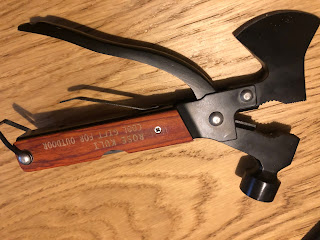
Here's another solid brass tool to add to my loadout of adaptive hardware. I'm always looking out for tools that can help me adapt to my environment or supplement my resources, especially if normal resources are unavailable or scarce. This particular tool turns plastic drinking bottles into cordage!
 You'd be pressed pretty hard to wander too far anywhere and not find modern trash. Plastic drinking bottles get thrown out of cars along roadways, get blown or dumped into waterways and turn up all over the place. The trick is to turn this abundant waste into useful product! Thats where a tool like the Cablelaid by Oceanus Brass comes in. Machined from solid brass bar stock, the tool is based around a simple principle; a razorblade, held in place behind a channel to feed the leading edge of the plastic through and cordage out the other side.
You'd be pressed pretty hard to wander too far anywhere and not find modern trash. Plastic drinking bottles get thrown out of cars along roadways, get blown or dumped into waterways and turn up all over the place. The trick is to turn this abundant waste into useful product! Thats where a tool like the Cablelaid by Oceanus Brass comes in. Machined from solid brass bar stock, the tool is based around a simple principle; a razorblade, held in place behind a channel to feed the leading edge of the plastic through and cordage out the other side.
The top plate of the tool is held in place by three inset Alan key screws, to facilitate swapping out of the simple razor blade in the event it dulls, though flipping it would double your cutting mileage, before replacement or sharpening is required.
 The tool has three channels built into the side that both guide the bottle in to the razor edge but also set the width of the cord produced. Notches set at 8mm, 6mm and 4mm to the blade with a 2mm guide slot along the top of the tool. The tool works by cutting the end of a plastic bottle off, then feeding the edge into the desired notch and the razor begins to cut the bottle into cordage. the notch then feeds the bottle in measured width to the razors edge and cordage exits out the back of the tool.
The tool has three channels built into the side that both guide the bottle in to the razor edge but also set the width of the cord produced. Notches set at 8mm, 6mm and 4mm to the blade with a 2mm guide slot along the top of the tool. The tool works by cutting the end of a plastic bottle off, then feeding the edge into the desired notch and the razor begins to cut the bottle into cordage. the notch then feeds the bottle in measured width to the razors edge and cordage exits out the back of the tool.
In order to maintain a constant pressure on the cutting edge and even bind-free cutting, it is beneficial to mount the bottle to the tool, such that it spools.

 To facilitate this, the tool has a hole bored through it, that fits a pen, pencil or the purpose made telescoping feed rod, its also helpful to anchor the tool in place, and a couple of nails serve the purpose well. Thus braced, its a matter of cutting an even strand, which takes a little finesse, and more than a few false starts. The more even the initial cut of the bottle is the better the start will be. as notched cord is weak and often snaps as it is drawn off the bottle.
To facilitate this, the tool has a hole bored through it, that fits a pen, pencil or the purpose made telescoping feed rod, its also helpful to anchor the tool in place, and a couple of nails serve the purpose well. Thus braced, its a matter of cutting an even strand, which takes a little finesse, and more than a few false starts. The more even the initial cut of the bottle is the better the start will be. as notched cord is weak and often snaps as it is drawn off the bottle.
I found that gripping the end of the cord in some pliers made for a good method, allowing me to focus on keeping an even tension on the cord, such that an even cutting would take place, free from pinching and mis-angled cuts.

From a standard 1.25L soft drink bottle, with a good clean start and careful processing i've been able to reliably cut 10-12m (32-40') of 8mm wide cord.
I've found that removing the label and washing out any sticky residue helps keep the cutting smooth and steady, but the first, initial cut to remove the base of the bottle seems most important. I also found that cutting from bottom to top is most successful.
The tool is pocket sized, at 114mm (~4 1/2") long, 23mm( ~15/16") wide and 11mm(~7/16") tall weighing a solid 184g (~6.5oz) but it'r rock solid and comfortable in the hand the way that solid brass is.
It can take either standard razor blades or alternatively box cutter blades, which fit into machined spots inside the tool.
The tail end of the tool features a lanyard hole, and comes fitted with a brass Bow-Shackle that is the signature of Oceanus Brass products. Versatile and useful on its own. A final nice touch is that the tool came with replacement blades, spare screws and Alan key as well as the telescopic rod in an all-included package.
Though the art of bottle-cordage conversion requires a certain finesse and practice, it's well worth attempting as an alternative to bought cord and thus far I've found a number of uses around the house and in the garden. More to follow.




























































